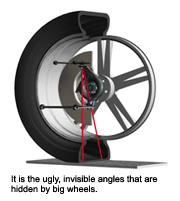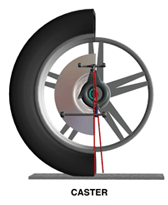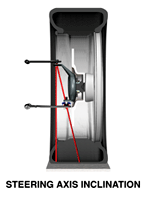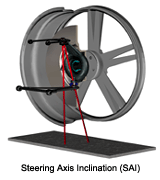Big rims or tires can look good and give a vehicle a unique look. But what is invisible becomes real ugly is the alignment and suspension angles that become altered. Also, that extra weight in stylist alloy rims or thick off-road tires can create a gyroscopic problem.
 Lifting
Lifting
Why do people lift trucks? The primary reason is to be able to fit larger wheel and tire combinations.
Light trucks and SUVs with wheels and tires that are 35-inches in diameter, combined with a lift kit, may be great for off roading, but they can have a scary effect on the way the steering reacts on a straight stretch of pavement at 70 MPH. Then there is the corner at 25 MPH where the steering wheel will not return to center or returns to center and oscillates.
A lift kit can raise the center of gravity of the vehicle and increases the possibility of a rollover. The manufacturer is required to place the following on a pickup or SUV sun visor: “This is a multipurpose passenger vehicle which will handle and maneuver differently from an ordinary passenger car in driving conditions which may occur on streets, highways and off road. As with other vehicles of this type, if you make sharp turns or abrupt maneuvers, the vehicle may rollover or may go out of control and crash. You should read driving guidelines and instructions in the owner’s manual, and wear your seat belt at all times.”
A lift kit makes this information even more important. Government rollover ratings for light trucks and SUVs can be found at www.safercar.gov. Some lift kits can also change the caster angle and change the point where it intersects with the ground. But some kits take extra care to relocate the suspension mounting point so that the extra height does not change the angles.
The offset of the new wheel is probably moved to accommodate the increase in rim width. The change in the offset moves the mounting flange of the wheel and changes the point where the flange centerline and steering axis inclination meet the ground. A change in offset can change the loading on the wheel bearings that can lead to a failure. This creates a scrub radius that will affect tire wear and can cause a change in stability.
Big rims can really look great on a passenger car too. If there is a change in ride height front to rear it can affect caster and steering. An increase in wheel and tire diameter can affect braking for all vehicles.
Steering Stabilizers
The steering stabilizer or damper for a truck or SUV can dampen a shimmy or a return-to-center condition. A steering damper for a passenger car is usually associated with manual steering on a passenger car with rack-and-pinion steering, and on the power steering linkage of light trucks and SUVs. A steering damper is a shock absorber with a 50/50 valve that applies the same hydraulic resistance in both directions.
The steering damper has to operate in a horizontal position. This means that there has to be a way to prevent aeration and foaming of the fluid in the reservoir where it compensates for fluid displacement as the shaft moves in and out of the damper.
In the early 1960s, General Motors developed a gas filled cushion that looked like a sandwich bag, which was inserted into the reservoir of a shock absorber. The bag would expand and collapse as the shaft moved in and out of the shock. They were first used on the 1965 Olds Toranado rear axle and steering linkage.
These units will solve the majority of steering problems, like shimmying and stability problems, but if the customer has a wheel and tire combination that is outside sane recommendations, the steering stabilizer may not be able to compensate for extreme wheel sizes.
In the instruction for a steering stabilizer kit, the manufacturer makes light of the possibility that these extreme wheel and tire packages can cause wear on the new steering stabilizer and the steering components:
“(Company name Removed) does not recommend a particular tire and wheel combination for use with its products and assumes no responsibility for customer choice of tires and wheels. Consult your owner’s manual for recommended tire sizes and warnings related to use of oversize tires and wheels. In general, larger tire and wheel combinations may increase stress and wear on steering components leading to increased maintenance and greater risk of component failure, including loss of steering control. Property damage or personal injury may result. Large tire and wheel combinations may also reduce braking effectiveness and alter vehicle center of gravity height (see product safety warnings). Remember, BIGGER isn’t necessarily better.”
 Short Long Arm
Short Long Arm
Many SUVs, most crossover vehicles and some import light trucks have both front and rear independent suspensions. An independent front or rear wheel suspension is either a strut suspension or a short long arm (SLA) suspension. How the components are mounted to the chassis configures the geometry of the suspension. In a strut suspension, the strut takes the place of the upper control arm, shock absorber and steering knuckle. The SLA suspension is made up of a steering knuckle and upper and lower control arm.
When the shock absorber is mounted to the lower control arm and chassis. Changes in wheel and tire size and chassis modifications can change a vehicle’s handling and braking characteristics. Here is a sample laundry list of conditions: harsh ride, wander, shimmy, steering wheel will not return to center, excessive lean, etc.
 A steering stabilizer may dampen some of the conditions, but it won’t correct them. Power steering is both an assist and a damper and most vehicles have power steering. The rate at which the power steering lines meter the flow of fluid to the piston is the same as if a manual steering damper would meter fluid through its piston. Modifications to the chassis can affect the built-in dampening of the power steering. A change in caster can make a power steering system overly sensitive.
A steering stabilizer may dampen some of the conditions, but it won’t correct them. Power steering is both an assist and a damper and most vehicles have power steering. The rate at which the power steering lines meter the flow of fluid to the piston is the same as if a manual steering damper would meter fluid through its piston. Modifications to the chassis can affect the built-in dampening of the power steering. A change in caster can make a power steering system overly sensitive.
Suspension geometry is what makes vehicle steering controllable. Track, caster, camber and toe are the four factors that control the stability of a vehicle in a straight line and around corners. Track is the alignment of the wheels to the centerline of the vehicle. The wheels for each axle are the same distance from the centerline and parallel to the centerline. Caster is the angle generated by a line through the center of the upper and lower ball joints and a vertical line through the center of the upper ball joint. Caster is positive when the angle is toward the front of the vehicle and negative when it is toward the rear.
Positive caster is used to cause the steering to center when traveling in a straight line and to return to straight from turning a corner. Camber is an angle generated by a line through the center of the wheel and vertical. Camber is positive when the top of the wheel is toward the outside of the vehicle and negative when toward the inside.
Toe is the angle through the center of the wheel and a line parallel the centerline. “Toe-in” is when the front of the wheel is angled inward to the center of the vehicle. “Toe-out” is when the wheel is angled outward and away from the center.
When vehicles had straight axles, the steering knuckle was attached to the axle with a kingpin. The kingpin is set at an angle that would cause it to run through the center of tire on the ground. This is called kingpin inclination. The purpose of the angle is to prevent the wheel from sliding sideways when the wheel is turned. Scrubbing is the term given to this sliding action.
Steering axis inclination (SAI) is the same as kingpin inclination. It is a line generated through the center of the upper and lower ball joint to the center of the tire on the ground. It is positive when the angle is inclined inward toward the center of the vehicle and negative when the angle is inclined outward. The distance between where the SLA and the centerline to the wheel intersect the ground is called the scrub radius. The scrub radius can affect the way the steering responds in both a straight line and cornering.
 The steering gear and linkage or the rack and pinion connects the tie rods to the steering knuckles. The location of the steering gear linkage or rack can have a profound affect on how the vehicle handles. The biggest affect is called bump steer. When a vehicle suspension travels over a bump the movement of the suspension and tie rod move in an arc. That movement can cause the wheel to turn in or out and disturb the direction of the vehicle especially in a straight line. A lift kit should ensure that the position of the tie rods do not change in relation to the suspension location. A change in position can cause a bump steer condition.
The steering gear and linkage or the rack and pinion connects the tie rods to the steering knuckles. The location of the steering gear linkage or rack can have a profound affect on how the vehicle handles. The biggest affect is called bump steer. When a vehicle suspension travels over a bump the movement of the suspension and tie rod move in an arc. That movement can cause the wheel to turn in or out and disturb the direction of the vehicle especially in a straight line. A lift kit should ensure that the position of the tie rods do not change in relation to the suspension location. A change in position can cause a bump steer condition.
The best performing suspension and steering systems have a quality that is called neutral steer. Neutral steer can be defined as a system that tracks straight and returns to straight with no over- or under-steer after turning. It also applies that there is no bump steer and minimal chassis roll. The steering will also have a controlled return to center when the wheel is released. This is where damping is used to slow the movement of the steering linkage to ensure that the wheel returns to center. Every OE system is engineered for safety and neutral steer.
So how does all of the information apply to a vehicle in your service bay or on the alignment rack? The condition of the suspension and its alignment are key to the safe operation of the vehicle. If you live in the northeast or midwest, the suspension is exposed to more severe conditions than in other parts of the country. The weather and road conditions can contribute to the deterioration of the components of the suspension and vehicle alignment. Yes, there are car-eating potholes everywhere you drive. When you are replacing the pads is a good time to take a look at the bushings, ball joints and tie rods. They could be part of the reason you are doing the brake job.
Safe and accurate steering is one of the most important contributors to the safe operation of a vehicle. Cover your assets by installing quality parts and aligning to specifications. If you do install modifications such as oversized wheels and tires or lift kits, make sure that the owner is aware of all of the warnings and safety precautions that come with the modifications. That label on the sun visor is twice as important when there is a lift kit involved.













